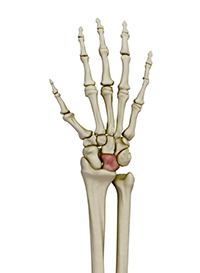
What is Kienbock's Disease?
Kienbock's disease is a condition in which the lunate, one of the small bones of the wrist, loses its blood supply leading to death of the bone. This results in pain, stiffness, and degenerative changes in the wrist joint.
Symptoms
The exact etiology of Kienbock's disease is unknown. Symptoms of Kienbock's disease include
- Painful and swollen wrist with decreased motion
- Reduced grip strength
- Difficulty or pain in turning the hand
- Tenderness in the area over the back of wrist near the lunate bone
Diagnosis
Kienbock's disease can be diagnosed by reviewing your medical history, performing a thorough physical examination of your hand and wrist and taking an X-ray. Your doctor may order an MRI to confirm the diagnosis.
Treatment
Treatment depends upon the severity and stage of the disease. In the earlier stages, treatment may involve anti-inflammatory medications and immobilization. Your doctor may recommend surgery if the pain is not relieved with the conservative treatment. The aim of surgery is to restore the blood supply to the lunate and may involve the following:
- Core decompression of the radius, which involves drilling into the radius bone to stimulate blood flow to the area
- Revascularization involves insertion of a vascularized bone graft into the lunate bone.
- Joint leveling refers to lengthening or shortening of the forearm bones (ulna and radius).
Fusion: Wrist arthrodesis, also called wrist fusion is a procedure in which the wrist joint is stabilized or immobilized by fusing the forearm bone (radius) with the small bones of the wrist.
Related Topics
- Wrist Fracture
- Fractures of the Hand and Fingers
- Wrist Sprain
- Flexor Tendon Injuries
- Distal Radioulnar Joint (DRUJ) Arthritis
- Ulnar Nerve Compression in Guyon's Canal
- Scaphoid Facture
- Industrial Hand Trauma
- Distal Radius Osteotomy to Correct Mal-Union (Crooked Painful Wrist)
- Distal Intersection Syndrome
- Distal Biceps Avulsion
- Adult Forearm Fractures
- Arthritis of the Hand and Wrist
- Arthritis of the Thumb
- Ganglion Cyst
- Boutonniere Deformity
- Carpal Tunnel Syndrome
- De Quervain's Tendinosis
- Dupuytren's Contracture
- Hand Pain
- Hand Infections
- Trapeziometacarpal (TMC) Arthritis
- Wrist Injuries
- Wrist Tumors
- Boxer's Fracture
- Swan Neck Deformity
- Carpal Instability
- Bennett's Fracture
- Kienbock's Disease
- Scapholunate Dissociation
- Triscaphoid Joint Arthritis
- Ulnar Carpal Impaction
- Triangular Fibrocartilage Complex Injury (TFCC)
- Guyon's Canal Syndrome
- Hand Masses
- Distal Radioulnar Joint (DRUJ) Instability
- Work Related Hand Injuries
- Wrist Ligament Tear and Instability
- Metacarpophalangeal Joint Arthritis





